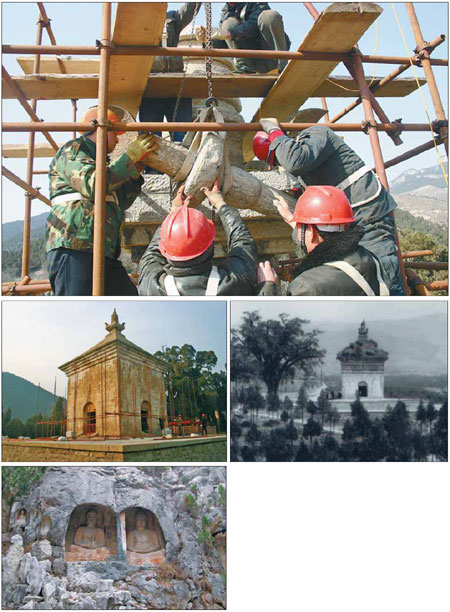
 |
|
Clockwise from top: Workers remove the stone spire of the Four Gates Pagoda during the recent renovation. A historical photo of the pagoda near Jinan, capital of Shandong province. The Akshobhya Buddha's head is displayed. Statues of the Thousand Buddha Cliff are weathering because of leaks. The pagoda is undergoing a major restoration. [Photos by Zhang Zixuan/ China Daily] |
China's oldest remaining one-story pavilion-style stone pagoda is undergoing major restoration to ensure the about 1,400-year-old building continues to stand tall.
As part of the Shentong Temple complex that is now in ruins, the Four Gates Pagoda, or Simen Pagoda, is a stupa built in the Sui Dynasty (AD 581-618) to store Buddhist relics. The State Council listed it among a first-batch cultural heritage site under State protection in 1961.
Located at the foot of Qinglong Mountain in rural Jinan, Shandong province, the pagoda is square, 7.4 meters wide on the sides and 15.04 meters high. Four doors have straight sides and arches on top.
The pyramidal pagoda roof is supported by a square stone pillar, with four Buddha statues on every face. The roof consists of 23 tiers of overlapping stone slabs and a stone steeple on top.
"The mission is to repair leaks that have begun to damage the Buddhist statues," says Wang Feng, deputy director of the Cultural Heritage Preservation Center of the Four Gates Pagoda.
The pagoda underwent major renovations during the early 1950s and 1970s to solve problems of sedimentation, cracking walls and spire weathering, Wang says.
He says waterproofing, however, remains a problem.
"This is partly attributed to the improper use of asphalt as pointing. Asphalt is rigid and cracks with age," says Tang Yang, director of the Shandong Cultural Heritage Protection Center's Design Office One and supervisor of the repairs.
"Using asphalt as pointing was still in the explorative stage in the 1970s. It's like new meds that prove to have side effects."
Mortar mixed with sand that causes water seepage is another problem. The repair project began in February. All the Buddha statues inside the pagoda were wrapped up, and the entire roof was dismantled with every stone numbered.
"The two pedestals of the steeple weigh 1 ton each, so it took a whole day to move them away," Wang says, adding the roof of the pagoda will be rebuilt using original stones and traditional construction methods.
The pointing agent will comprise egg white and glutinous rice paste, and the adhesive among the filled stones will be a clay and plaster mix, so it won't crack.
Mei Xingwu, a stonemason lives next to the main entrance of the Four Gates Pagoda Scenic Area, says this is the correct approach.
"Traditional techniques have been tested for more than 1,000 years, which makes them deserving of respect," he says.
His father, Mei Dianlong, who's also a stonemason, participated in the pagoda's restoration in 1972. Part of the steeple was his work.
In 1997, the head of the Akshobhya Buddha on the eastern wall of the pagoda's center pillar was stolen. In 2002, when it was retrieved and returned to the pagoda, the younger Mei was part of a team that seamlessly glued it back on.
"It's good that the pagoda hasn't changed much through the years, and the repairs have only made it stronger," Mei says.
A stone case was discovered in the center stone pillar in 1973. Inside was a colored copper case filled with Buddhist relics. Also, a stone inscription discovered above a triangle stone beam says the pagoda was "built in the seventh year of the Sui Dynasty's Daye period", which is AD 611.
During the ongoing restoration project, a sealed stone vase was found in the roof. Inside was a bottle containing drawing sheets and documents.
"They are records of the last repair project, which were stored in the roof when the repairs were done in 1973," Wang says, adding this will be done again.
Tang, the restoration project supervisor, says: "The repairs will ensure the pagoda lasts at least another 50 years."
Additionally, two pavilions from the Ming Dynasty (1368-1644) that are near the pagoda are undergoing repairs that are scheduled to be completed by the end of May. They will be followed by repairs of relief sculptures on a stone pedestal made in the Tang Dynasty (AD 618-907).
Meanwhile, the Thousand-Buddha Cliff, carved with more than 210 Tang statues and 43 inscriptions, is weathering because of leaks, Wang says.
A repair plan is expected to be launched in 2013, once it's approved by the State Administration of Cultural Heritage.